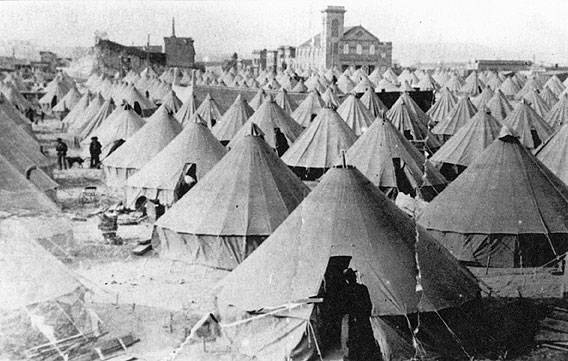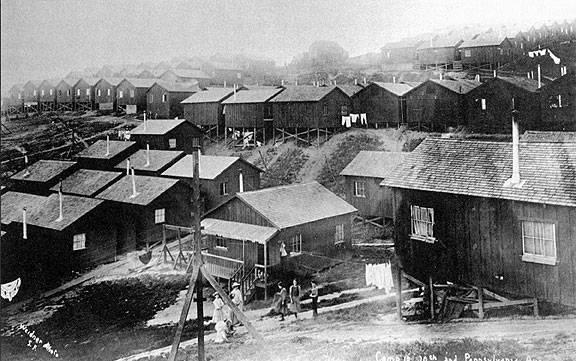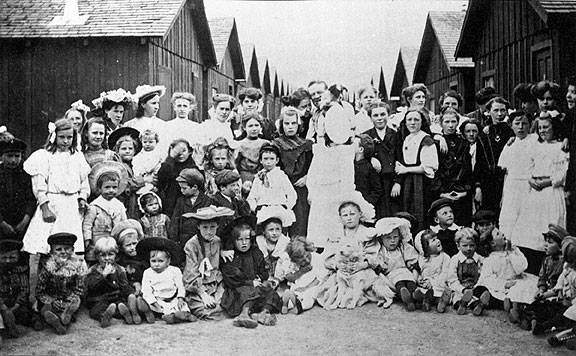1906 Changes The Hill Forever: Difference between revisions
No edit summary |
No edit summary |
||
| Line 1: | Line 1: | ||
[[Image:1906-tent-city-potrero-hill-area.jpg]] | [[Image:1906-tent-city-potrero-hill-area.jpg]] | ||
'''Army surplus tents from the Spanish-American War were set up from 19th to 22nd St. between Indiana and Kentucky (today's 3rd Street), beneath Potrero Hill.''' | '''Army surplus tents from the [[SAN FRANCISCO'S ROLE IN THE WAR IN THE PHILIPPINES|Spanish-American War]] were set up from 19th to 22nd St. between Indiana and Kentucky (today's 3rd Street), beneath Potrero Hill.''' | ||
''Photo: Potrero Hill Archives Project'' | ''Photo: Potrero Hill Archives Project'' | ||
Revision as of 22:14, 25 August 2008
Army surplus tents from the Spanish-American War were set up from 19th to 22nd St. between Indiana and Kentucky (today's 3rd Street), beneath Potrero Hill.
Photo: Potrero Hill Archives Project
1906 Earthquake/fire refugee housing at 20th and Pennsylvania Streets on Potrero Hill
Photo: Potrero Hill Archives Project
Nineteen-six, the year of the earthquake and fire, marked a period of change on Potrero Hill. Potrero Hill gained much publicity after the earthquake. Several newspaper articles were written, stating that it was one of the safest places to be in case of another earthquake.
The "South of Market" people, forced out of their homes by fire, quickly escaped to the Potrero slopes of green pastures and scattered settlements. The residents of Potrero at that time could clearly remember the masses of people carrying assorted personal belongings; a bird on a woman's shoulder, a man carrying one chair, another carrying a blanket. Up the hill they wound their way, where they watched the burning of San Francisco.39 Here on the green pastures of Potrero, the people without homes settled. During the period of reconstruction that followed the fire, small two-room shacks were built by the city for refugees. Many of these still stand, and can be spotted by the presence of the building on the back of the lot.
The small temporary dwellings were scattered all over the hill, and thus the area of Potrero began to develop as an integrated community, instead of the various groups located in certain areas.
The refugee camps, as they were called, lived a different life from that of the permanent residents of the hill. One resident could remember the area along Iowa and Nineteenth Streets when it was called the "Nursing Settlement." This was a community center for the refugees, where they could obtain medical assistance from nurses. The woman in charge of the center was Mrs. Sweitzer.
Ellie Baine was eight years old when the 1906 quake and fire hit. She is sitting in the middle of the front row with her dog in this camp at 20th near Iowa.
Photo: Potrero Hill Archives Project
Many of the refugee children played in this area and were indeed the envy of the neighborhood children. One man could remember pretending he was a refugee so he could go over and play at the "Nursing Settlement."(40)
The "South of Market" people were generally uneducated laborers who took pride in physical strength and work. Some of the refugees left Potrero during the reconstruction period, but many stayed, and this period of time marked the first important development of Potrero.(41)
After 1906, the buildings on Potrero began to increase in numbers. Occupying these buildings were many different groups of people. They belonged to the working class of people. The hill was fragrant with the aroma of industry, homemade stew, sweet grass, and wild flowers. As the fog came rolling in through the Gate, swirling and licking at the downtown ruins, the people must have felt the excitement of the unknown.
These people were immigrants, working people, with the desire to have a good life. Here was a diversity of people from all parts of the world. Yet, each group contributed its energy and ambition to the rebuilding of San Francisco and the development of Potrero Hill.
Another resident could remember how the city planners tried to decide whether to rebuild the residential area of San Francisco, south of Market on Potrero Hill, and the Industrial part of the city on the north side of Market.42 It isn't known exactly why the decision was reversed. Some commented that Butchertown, [now] in southern San Francisco, wouldn't move from its site. In the early years of San Francisco, Butchertown was closer to Potrero Hill. The reason for its final move was the need to operate close to bay water. Its present situation corresponds to the receding of the bay and fill-in of the mud flats between Potrero and the downtown area of the city. [Now,] in place of a residential area south of Market, there is instead the main industrial heart of the city.
--by Cheryl and Clark Kaplan, 1964



